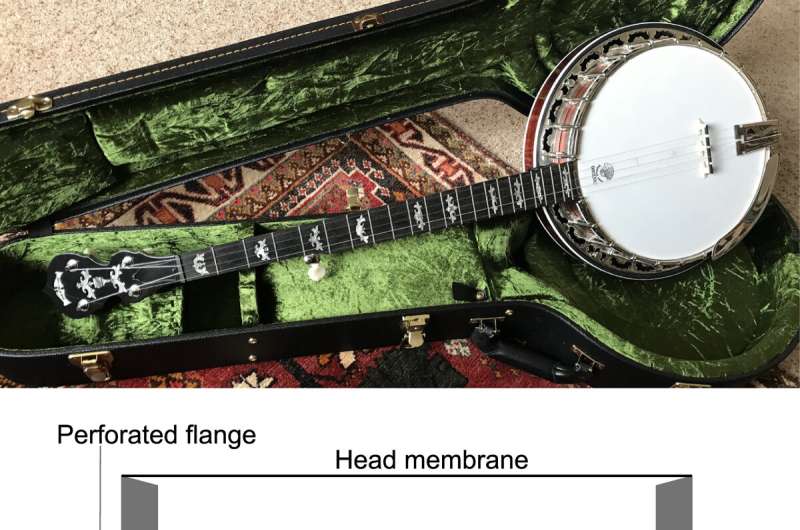Researchers measure and synthesize the musical acoustics of a 5-string banjo

Musical instruments bring delight to players and listeners alike. Creating the voice—or characteristic style and tone—of an instrument is an exquisite balance of physics and craftsmanship. To date, there has been little analysis of the acoustics responsible for different plucked-string instruments' distinct voices.
Now, a team led by Jim Woodhouse, an emeritus professor at Cambridge University's Department of Engineering, UK, has studied the physical features responsible for a 5-string banjo's voice. They compare the results to a steel-string guitar.
The study, published in Acta Acustica, is co-authored by David Politzer, a Nobel Prize-winning physicist based at CalTech in the US and acoustics specialist Hossein Mansour. Mansour was working with French technology company Dassault Systèmes at the time.
The open access article contains embedded audio clips that bring the research to life.
Construction and physics for voice
To investigate the acoustics responsible for the banjo's immediately recognizable voice, the researchers measured the instrument's vibrational response and studied how the sound it makes is influenced by constructional parameters.
"In the banjo, unusually among stringed instruments, many of these parameters can be adjusted by the maker or player so it's useful to understand how such adjustments work," says Woodhouse.
The team used physical modeling synthesis to probe the acoustics. Mathematical models were computed, tested and calibrated in the laboratory and used to synthesize sound examples. The researchers showed that the models could produce "convincingly banjo-like" sounds.
These synthesized sounds were central to the work so they have been embedded as audio clips in the article. Traditionally, such clips would be available as supplementary material to be downloaded. "The embedded files give the reader a far easier time and allow a much more immediate response," says Woodhouse.
Contrasts and discoveries
The structure of a banjo differs from that of a guitar. Banjos have a drum-like stretched membrane rather than a wooden plate for a soundboard, and this impacts on acoustics.
"The strings couple much more strongly to the vibration of the soundboard. The result is that notes on a banjo are louder than corresponding notes on a guitar, and decay more rapidly," explains Woodhouse.
Through analysis of the models, the team also made a more surprising discovery. Unlike previous work on violins and guitars, the banjo study demonstrates how sound is influenced by acoustic structures called formants.
"Underlying the fine structure of individual resonances, there can be formants, larger-scale structures, shaping the frequency distribution of sound radiated by the instrument," says Woodhouse.
Structural adjustments to the banjo can be used to control the formants and thus tweak the tone of the instrument.
"The banjo gives an extreme case of the mode/formant contrast: changes that affect individual resonances seem to be much less important, in terms of sound, than changes that affect the formants."
Working in the field of musical acoustics—where physics is combined with human perception and judgment—calls for an unusual approach to research, says Woodhouse.
"With musical problems, the physics questions have to be teased out by interaction with makers and players of instruments. You get to meet a lot of interesting people doing this kind of work!"
More information: Jim Woodhouse et al. Acoustics of the banjo: theoretical and numerical modeling, Acta Acustica (2021). DOI: 10.1051/aacus/2021008
Provided by SciencePOD




















